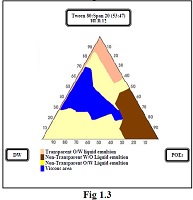Study of Pseudoternary Phase Diagram Behaviour and the Effect of Several Tweens and Spans on Palm Oil Esters Characteristics
Keywords:
palm oil esters, Tween, Span, Pseudoternary phase diagram, O/W emulsionAbstract
Palm oil esters are high molecular weight esters oil that has been newly synthesized by University Putra Malaysia researchers. It has received a lot of attention for its pharmaceutical and chemical application. The aim of this study is to study the effects of the palm oil esters with different HLB surfactant mixture on the ternary diagrams behaviour and to confine the various systems resulted from these combinations. These systems include traditional emulsion, gel area, transpernat micro-emulsion area, O/W and W/O emulsions. In this study, pseudoternary phase diagrams of water, POEs and non-ionic surfactant mixture of several HLB values were constructed using water titration method. The resultant mixtures collected after each addition and mixing of water were analysed visually, along with conductivity, dilution in water and dye test (methylene blue) to classify them as O/W emulsion (transparent and opaque) or W/O (opaque) and liquid or gel. As a conclusion, palm oil esters were found to be suitable for the formulation of different types of emulsion. Additionally, different HLB value of non-ionic surfactant(s) exhibited different pseudoternary phase diagram characteristics.
References
O’Brien RD. Fats and Oils: Formulating
and Processing for Applications. CRC
Press: Boca Raton; 2004.
Keng PS, Basri M, Zakaria MRS,
AbdulRahman MB, Ariff AB,
AbbdulRahman RNZ, Salleh AB. Newly
synthesized palm esters for cosmetics
industry. Indus Crops prod 2009; 29 (1):
-44.
Keng PS, Mahiran B, Abdul Rahman MB,
Salleh AB, Abdul Rahman RNZ, Ariff A.
Optimization of palm-based wax esters
production using statistical experimental
designs. J Oleo Sci 2005; 54: 519-528.
Keng PS, Mahiran B, Abdul Rahman MB,
Salleh AB, Abdul Rahman RNZ, Ariff A.
Scale-up synthesis of lipase-catalyzed palm
esters in stirred-tank reactor. Bioresource
Technol 2008; 99: 6097–6104.
Lakatos-Szabó J, Lakatos I. Effect of nonionic surfactants on interfacial rheological
properties of crude oil/water systems. Prog
Colloid Poly Sci 1997; 105: 302-310.
Peltonen L, Hirvonen J, Yliruusi J. The
behavior of sorbitan surfactants at the
water–oil interface: Straight-chained
hydrocarbons from pentane to dodecane as
an oil phase. J Colloid Int Sci 2001: 240:
-276.
Hayati IN, Binche M, Chinping T, Aini IN.
Stability and rheology of concentrated O/W
emulsions based on soybean oil/palm
kernel olein blends. Food Res Int 2007; 40:
-1061.
Kónya M, Dékány I, Erõs I. X-ray
investigation of the role of the mixed
emulsifier in the structure formation in
O/W creams. Coll Poly Sci 2007; 285:
-663.
Baroli B, López-Quintela MA, DelgadoCharro MB, Fadda, AM , Blanco-Méndez
J. Micro-emulsions for topical delivery of
-methoxsalen. J Contr Rel 2000; 69: 209-
Whitehead K, Karr N, Mitragotri S. Safe
and effective permeation enhancers for
oral drug delivery. Inflammopharmacology
; 25: 1782-1788.
Fang J-Y, Yu S-Y, Pao-Chuwu H, Huang
Y-B, Tsai Y-H. In vitro skin permeation of
estradiol from various proniosome
formulations. Int J Pharm 2001; 215: 91-
Marrzan LL, Samseth J, Quintela ML.
Structure of concentrated nonionic
surfactant micro-emulsions studied by
small angle neutron scattering. J De
Physique IV 1993; 3: 165-169.
Korhonen M, Niskanen H, Kiesvaara J,
Yliruusi J. Determination of optimal
combination of surfactants in creams using
rheology measurements. Int J Pharm 2000;
: 143-151.
Gi H-J, Chen S-N, Hwang J-S, Tien C,
Kuo MT. Studies of formation and
interface of oil-water micro-emulsion.
Chineese J Phys 1992; 30: 665-678.
Lia P, Ghosha A, Wagnera RF, Krillb S,
Joshia YM, Serajuddina ATM. Effect of
combined use of nonionic surfactant on
formation of oil-in-water micro-emulsions.
Int J Pharm 2005; 288: 27-34.
Cho YH, Kim S, Bae EK, Mok CK, Park J.
Formulation of co surfactant-free O/W
micro-emulsion using nonionic surfactant
mixture. Food Eng Phys Prop 2008; 73:
E115-E121.
Lawrence MJ, Rees GD. Micro-emulsionbased media as novel drug delivery
systems. Adv Dr Del Rev 2000; 45: 89-
Prinderre P, Piccerelle P, Cauture E,
Kalantzis G, Reynier JP, Joachim J.
Formulation and evaluation of O/W
emulsions using experimental design. Int J
Pharm 1998; 163: 73-79.
Junginger HE. Ointments and creams as
colloidal drug delivery system. In: Kreuter
J, editors. Colloidal Drug Delivery
Systems. New York: Marcel Dekker; 1994.
p. 1-45.
Jiao J, Burgess DJ. Rheology and stability
of Water-in-Oil-in-Water multiple
emulsions containing Span 83 and Tween
AAPS 2003; 5: 1-12.
Barakat Y, Gendy TS, Ibrahim V.
Surfactants with natural hydrophobic tails
HLB-CMC relationship of
polyoxyethylenated cholesterol. Aust J
Basic Appl Sci 2008; 2: 372-380.





